Natural Fractures Characterization and In Situ Stresses Inference in a Carbonate Reservoir—An Integrated Approach
Abstract
:1. Introduction
- Understanding the structural fabric of the sedimentary basins and rock densification,
- Evaluation of stress and pressure controlled hydrocarbon migration episodes in exploration activities (paleo-stresses),
- Calculation of mud-weight windows for safe drilling (blow-out prevention),
- Determination of optimum drilling trajectories to reduce borehole instability in shales,
- Evaluation of horizontal well placement in reservoirs with horizontal permeability anisotropy arising from stressed natural fracture fabric,
- Casing shoe depth choice in mildly and strongly over-pressured regimes,
- Casing design including casing-rock interaction potential during production leading to shear or parting,
- Design of cementing operations to avoid drilling fluids losses (in both natural and induced fractures),
- Well completion design to manage or exclude sand,
- Design of hydraulic fracture installations,
- Assessment of compaction potential and magnitude,
- Evaluation of potential fault reactivation,
- Thermal stress calculations in thermal EOR or cold water flooding,
- Microseismic monitoring data interpretation,
- Interpretation of acoustical wave velocity and quality changes in 4-D seismic surveys or tomographic surveys,
- Design and evaluation of liquid and solid deep well waste disposal,
- Site characterization for geological CO2 storage
- Autopsies and post-analysis of unexpected problems in drilling and production
2. Kuh-e-Mond Heavy Oil Field
3. Fracture Characterization
3.1. Field Geological and Core Studies
3.2. Seismic Surveys
Side View Seismic Location Survey
- The upper part of the section (up to ~0 m) is intensely fractured (from 0 to 800 m);
- Below is a zone with a minimum fracturing intensity (800–1200 m);
- Next, to a depth of ~4000 m, is an intensely fractured zone
- And, in the deepest interval, fracturing intensity decreases sharply
3.3. FMI and UBI Image Logs
3.4. Earth Stresses—Geological Inference
3.4.1. Magnitude of the In Situ Principal Stresses
3.4.2. Orientations of the In Situ Stresses
3.4.3. Pore Pressure Estimation
4. Results and Discussion
4.1. Origins of Natural Fractures in the Study Area
4.2. Present Day Stress Field Orientation in the Study Area
5. Conclusions
- Integrated studies of natural fracture systems in fractured reservoirs can be instrumental in E&P projects and site characterization practices for geological CO2 sequestration projects.
- Borehole image logs, FMI and UBI, proved to be useful tools in identifying and characterizing natural fractures in the study area.
- The studied reservoirs, including regions in both Jahrum and Sarvak formations are highly fractured. Three dominant orientations were identified for vertical and sub-vertical fractures atop the crestal region of the anticlinal structure: N, NE and E. Both the surface and subsurface fractures are shear fracture type of tectonic origin nearly in the same direction. Distribution of open fracturing in the study area depends on tectonic, lithology, overburden and rock dilation. Tectonics is the major factor.
- NE-SW and NW-SE found to be the dominant orientations for maximum and minimum horizontal stresses in the study area.
- Most fractures are steep, N-S to NNE trending structures with dip azimuth towards the E to EES. This suggests that the Persian Gulf Sedimentary Basin seems to be detached.
- From image logs, the strike azimuth of the drilling induced fracture is N45°W, which indicates that the orientation of σHMAX = σ1 around the well MD-8 is NE-SW; the orientation of σhmin = σ3 is NW-SE and σ2 is vertical. Azimuths of σ1 and σ3 in the study area are 030° to 035° and 120° to 125°; respectively.
- Estimated magnitudes of the in situ principal stresses and pore pressure at depth of 1200 m in well MD-8 are: Po = 11.77 MPa, σ2 = σV = 30 MPa, σ3 = σhmin = 13.5 MPa and σ1 = σHMAX = > σ2 = σV = 30 MPa > σ3 = σhmin = 13.5 MPa.
Author Contributions
Conflicts of Interest
References
- Dusseault, M.B.; Shafiei, A. Oil Sands; Ullmann’s Encyclopedia of Chemical Engineering; Wiley: Hoboken, NJ, USA, 2011; p. 52. [Google Scholar] [CrossRef]
- Rogner, H.H.; Aguilera, R.F.; Archer, C.; Bertani, R.; Bhattacharya, S.C.; Dusseault, M.B.; Gagnon, L.; Haberl, H.; Hoogwijk, M.; Johnson, A.; et al. Chapter 7—Energy Resources and Potentials. In Global Energy Assessment—Toward a Sustainable Future; Cambridge University Press: Cambridge, UK; New York, NY, USA; International Institute for Applied Systems Analysis: Laxenburg, Austria, 2012; pp. 423–512. ISBN 978-0-52-118293-5. [Google Scholar]
- Saidi, A.M. Reservoir Engineering of Fractured Reservoirs—Fundamental and Practical Aspects; TOTAL Edition Press: Paris, France, 1987. [Google Scholar]
- Rutqvist, J.; Wu, Y.S.; Tsang, C.F.; Bodvarsson, G. A modeling approach for analysis of coupled multiphase fluid flow, heat transfer and deformation in fractured porous rock. Int. J. Rock Mech. Min. Sci. Eng. 2002, 39, 429–442. [Google Scholar] [CrossRef]
- Rutqvist, J.; Stephansson, O. The role of hydromechanical coupling in fractured rock engineering. Hydrogeol. J. 2003, 11, 7–40. [Google Scholar] [CrossRef]
- Yang, Y.; Liu, Z.; Sun, S.; An, S.; Zhang, W.; Liu, P.; Yao, J.; Ma, J. Research on Stress Sensitivity of Fractured Carbonate Reservoirs Based on CT Technology. Energies 2017, 10, 1833. [Google Scholar] [CrossRef]
- Chong, Z.; Li, X.; Chen, X.; Zhang, J.; Lu, J. Numerical Investigation into the Effect of Natural Fracture Density on Hydraulic Fracture Network Propagation. Energies 2017, 10, 914. [Google Scholar] [CrossRef]
- Fang, J.; Zhou, F.; Tang, Z. Discrete fracture network modelling in a naturally fractured carbonate reservoir in the Jingbei oilfield, China. Energies 2017, 10, 183. [Google Scholar] [CrossRef]
- Salimi, S.; Ghalambor, A. Experimental study of formation damage during underbalanced drilling in naturally fractured formations. Energies 2011, 4, 1728–1747. [Google Scholar] [CrossRef] [Green Version]
- Shafiei, A. Mathematical and Statistical Investigation of Steamflooding in Naturally Fractured Carbonate Heavy Oil Reservoirs. Ph.D. Thesis, University of Waterloo, Waterloo, ON, Canada, 2013. [Google Scholar] [CrossRef]
- Shafiei, A.; Zendehboudi, S.; Dusseault, M.B.; Chatzis, I. Mathematical model for steam flooding in naturally fractured reservoirs. Ind. Eng. Chem. Res. 2013, 52, 7993–8008. [Google Scholar] [CrossRef]
- Shafiei, A.; Dusseault, M.B. Geomechanics of thermal oil production from carbonate reservoirs. J. Porous Media 2014, 17, 301–321. [Google Scholar] [CrossRef]
- Nelson, R. Geologic Analysis of Naturally Fractured Reservoirs; Gulf Professional Publishing: Houston, TX, USA, 2001; ISBN 978-0-88-415317-7. [Google Scholar]
- Morgenstern, N.R. A relation between hydraulic fracture pressure and tectonic stresses. Geofis. Pura Appl. 1962, 52, 104–114. [Google Scholar] [CrossRef]
- Kashnikov, Y.A.; Ashikhmin, S.G. Influence of oil recovery on the change in the stress-strain state of rock mass. Part III: Technogenic activation of fault structures. J. Min. Sci. 2000, 36, 244–252. [Google Scholar] [CrossRef]
- Nolen-Hoeksema, R.C.; Rabaa, A.W.M. Waterflood improvement in the Permian Basin: Impact of in situ stress evaluations. SPE Res. Eng. 1994, 9, 254–260. [Google Scholar] [CrossRef]
- Tingay, M.; Müller, B.; Reinecker, J.; Heidbach, O.; Wenzel, F.; Fleckenstein, P. Understanding tectonic stress in the oil patch: The World Stress Map Project. TLE 2005, 24, 1276–1282. [Google Scholar] [CrossRef]
- Banks, D.; Odling, N.E.; Skarphagen, H.; Rohr-Torp, E. Permeability and stress in crystalline rocks. Terra Nova 1996, 8, 223–235. [Google Scholar] [CrossRef]
- Bell, J.S. In situ stresses in sedimentary rocks (Part 1): Measurement techniques. Geosci. Can. 1996, 23, 85–100. [Google Scholar]
- Bell, J.S. In situ stresses in sedimentary rocks (Part 2): Applications of stress measurements. Geosci. Can. 1996, 23, 135–153. [Google Scholar]
- Heffer, K. Geomechanical influences in water injection projects: An overview. Oil Gas Sci. Technol. 2002, 57, 415–422. [Google Scholar] [CrossRef]
- Heffer, K.J.; Fox, R.J.; McGill, C.A. Novel techniques show links between reservoir flow directionality, earth stress, fault structure and geomechanical changes in mature waterfloods. SPE 1995, 2. [Google Scholar] [CrossRef]
- Henk, A. Pre-drilling prediction of the tectonic stress field with geomechanical models. First Break 2005, 23, 53–57. [Google Scholar] [CrossRef]
- Araújo, J.S.; Vieira, M.M.; Bezerra, F.H.R. Influence of tectonic stresses in the permeability of petroliferous reservoir in Potiguar Basin, Brazil. In Proceedings of the SPE Latin American and Caribbean Petroleum Engineering Conference, Cartagena, Colombia, 31 May–3 June 2009. [Google Scholar]
- Yang, W.; Lin, B.Q.; Wu, H.J. Study of the stress relief and gas drainage limitation of a drilling and the solving mechanism. Proc. Earth Planet. Sci. 2009, 1, 371–376. [Google Scholar]
- Kosari, E.; Ghareh-Cheloo, S.; Kadkhodaie-Ilkhchi, A.; Bahroudi, A. Fracture characterization by fusion of geophysical and geomechanical data: A case study from the Asmari reservoir, the Central Zagros fold-thrust belt. J. Geophys. Eng. 2015, 12, 130–143. [Google Scholar] [CrossRef]
- Denga, H.; Stauffera, P.H.; Daia, Z.; Jiao, Z.; Surdamb, R.C. Simulation of industrial-scale CO2 storage: Multi scale heterogeneity and its impacts on storage capacity, injectivity and leakage. IGGGC 2012, 10, 397–418. [Google Scholar] [CrossRef]
- Bacon, D.H.; Qafoku, N.P.; Dai, Z.; Keating, E.H.; Brown, C.F. Modeling the impact of carbon dioxide leakage into an unconfined, oxidizing carbonate aquifer. IJGGC 2016, 44, 290–299. [Google Scholar] [CrossRef]
- Liu, H.; Zhang, X.; Lu, X.; Liu, Q. Study on flow in fractured porous media using pore-fracture network modeling. Energies 2017, 10, 1984. [Google Scholar] [CrossRef]
- Bashari, A. Occurrence of heavy crude oil in the Persian Gulf. In Proceedings of the 4th UNITAR/UNDP International Conference on Heavy Crude and Tar Sands, Edmonton, AB, Canada, 7–12 August 1988; pp. 203–214. [Google Scholar]
- Moshtaghian, A.; Malekzadeh, R.; Azarpanah, A. Heavy oil discovery in Iran. In Proceedings of the 4th UNITAR/UNDP International Conference on Heavy Crude and Tar Sands, Edmonton, AB, Canada, 7–12 August 1988; pp. 235–243. [Google Scholar]
- Tunini, L.; Jimenez-Munt, I.; Fernandez, M.; Verges, J.; Villasenor, A. Lithospheric mantle heterogeneities beneath the Zagros Mountains and the Iranian Plateau: A petrological-geophysical study. Geophys. J. Int. 2015, 200, 596–614. [Google Scholar] [CrossRef]
- Kamali, M.R.; Rezaee, M.R. Burial history reconstruction and thermal modeling at Kuh-e-Mond, SW Iran. J. Pet. Geol. 2003, 26, 451–464. [Google Scholar] [CrossRef]
- James, G.A.; Wynd, J.G. Stratigraphic nomenclature of Iranian Oil Consortium Agreement Area. AAPG Bull. 1965, 49, 2182–2245. [Google Scholar]
- Kouznetsov, O.L.; Faizulline, I.S.; Chirkine, I.A.; Meltchouk, B.Y.; Khisamov, R.S.; Slenkin, S.I.; Kashirin, G.V. Applying scattered seismic waves to study 3-D distribution of fracturing in geomedium (SVSL method). In Proceedings of the Iranian 11th Oil, Gas and Petrochemical Congress, Tehran, Iran, 11 June 2001. [Google Scholar]
- Daneshy, A.A.; Slusher, G.L.; Chisholm, P.T.; Magee, D.A. In situ stress measurements during drilling. JPT 1986, 38, 891–898. [Google Scholar] [CrossRef]
- Prensky, S.E. Advances in borehole imaging technology and applications. In Borehole Imaging: Applications and Case Histories; Lovell, M.A., Williamson, G., Harvey, P.K., Eds.; The Geological Society of London, Special Publications: London, UK, 1999; Volume 159, pp. 1–43. [Google Scholar]
- Hubbert, M.K.; Willis, D.G. Mechanics of hydraulic fracturing. Trans. AIME 1957, 210, 153–166. [Google Scholar]
- Bredehoeft, J.; Wolff, R.; Keys, W.; Shuter, E. Hydraulic fracturing to determine the regional in situ stress field, Piceance Basin, Colorado. GSA Bull. 1976, 87, 250–258. [Google Scholar] [CrossRef]
- Sheory, P.R. A theory for in situ stresses in isotropic and transversely isotropic rock. Int. J. Rock Mech. Min. Sci. Geomech. Abstr. 1994, 31, 23–34. [Google Scholar] [CrossRef]
- Becker, A.; Blümling, P.; Müller, W.H. Recent stress field and neotectonics in the Eastern Jura Mountains, Switzerland. Tectonophysics 1987, 135, 277–288. [Google Scholar] [CrossRef]
- Adams, J. Stress-relief buckles in McFarland Quarry, Ottawa. Can. J. Earth Sci. 1982, 19, 1883–1887. [Google Scholar] [CrossRef]
- Wallach, J.; Benn, K.; Rimando, R. Recent, tectonically induced, surficial stress-relief structures in the Ottawa-Hull area, Canada. Can. J. Earth Sci. 1995, 32, 325–333. [Google Scholar] [CrossRef]
- Engelder, T. Stress Regimes in the Lithosphere; Princeton University Press: Princeton, NJ, USA, 1993. [Google Scholar]
- Zarifi, Z.; Nilfouroushan, F.; Raeesi, M. Crustal stress map of Iran: Insight from seismic and geodetic computations. Pure Appl. Geophys. 2014, 171, 1219–1236. [Google Scholar] [CrossRef]
- Berbrian, M.; King, G.C.P. Towards a paleogeography and tectonic evolution of Iran. Can. J. Earth Sci. 1981, 18, 210–265. [Google Scholar] [CrossRef]
- Al-Laboun, A.A. Stratigraphy and hydrocarbon potential of the Paleozoic succession in both the Tabuk and Widyan basins, Arabia. In Future Petroleum Provinces of the World; Halbouty, M.T., Ed.; AAPG Memoir: Tulsa, OK, USA, 1986; Volume 40, pp. 373–397. [Google Scholar]
- Alsharhan, A.S.; Nairn, A.E.M. Sedimentary Basins and Petroleum Geology of the Middle East; Elsevier Science: New York, NY, USA, 1997; p. 878. ISBN 978-0-44-482465-3. [Google Scholar]
- Al-Husseini, M.I. Origin of the Arabian plate structures: Amar collision and Najd rift. GeoArabia 2000, 5, 527–542. [Google Scholar]
- Alavi, M. Regional stratigraphy of the Zagros fold-thrust belt of Iran and its proforeland evolution. Am. J. Sci. 2004, 304, 1–20. [Google Scholar] [CrossRef]
- Aubourg, C.; Smith, B.; Eshraghi, A.; Lacombe, O.; Authemayou, C.; Amrouch, K.; Bellier, O.; Mouthereau, F. New magnetic fabric data and their comparison with palaeostress Markers. In The Western Fars Arc (Zagros, Iran.): Tectonic Implications; The Geological Society of London, Special Publications: London, UK, 2010; Volume 330, pp. 97–120. [Google Scholar]
- Shariatinia, Z.; Haghighi, M.; Feiznia, S.; Alizai, A.H.; Levresse, G. Hydrocarbon migration in the Zagros Basin, offshore Iran, for understanding the fluid flow in the Oligocene–Miocene carbonate reservoirs. Russ. Geol. Geophs. 2013, 54, 64–81. [Google Scholar] [CrossRef]
- Heidbach, O.; Tingay, M.; Barth, A.; Reinecker, J.; Kurfeß, D.; Müller, B. The World Stress Map Database Release. 2008. Available online: http://dc-app3-14.gfz-potsdam.de/pub/poster/World_Stress_Map_Release_2008.pdf (accessed on 8 December 2017).
- Colman-Saad, S.P. Fold development in Zagros simply folded belt, southwest Iran. AAPG Bull. 1978, 62, 984–1003. [Google Scholar]
- Ge, S.; Garven, G. Hydromechanical modeling of tectonically driven groundwater flow with application to the Arkoma Foreland basin. J. Geophys. 1992, 97, 9119–9144. [Google Scholar] [CrossRef]
- Hansom, J.; Lee, M. Effects of hydrocarbon generation, basal heat flow and sediment compaction on overpressure development: A numerical study. Pet. Geosci. 2005, 11, 353–360. [Google Scholar] [CrossRef]
- Vaziri-Moghaddam, H.; Seyrafian, A.; Taheri, A.; Motiei, H. Oligocene-Miocene ramp system (Asmari Formation) in the NW of the Zagros basin, Iran: Microfacies, paleoenvironment and depositional sequence. Rev. Mex. Cienc. Geol. 2010, 27, 56–71. [Google Scholar]
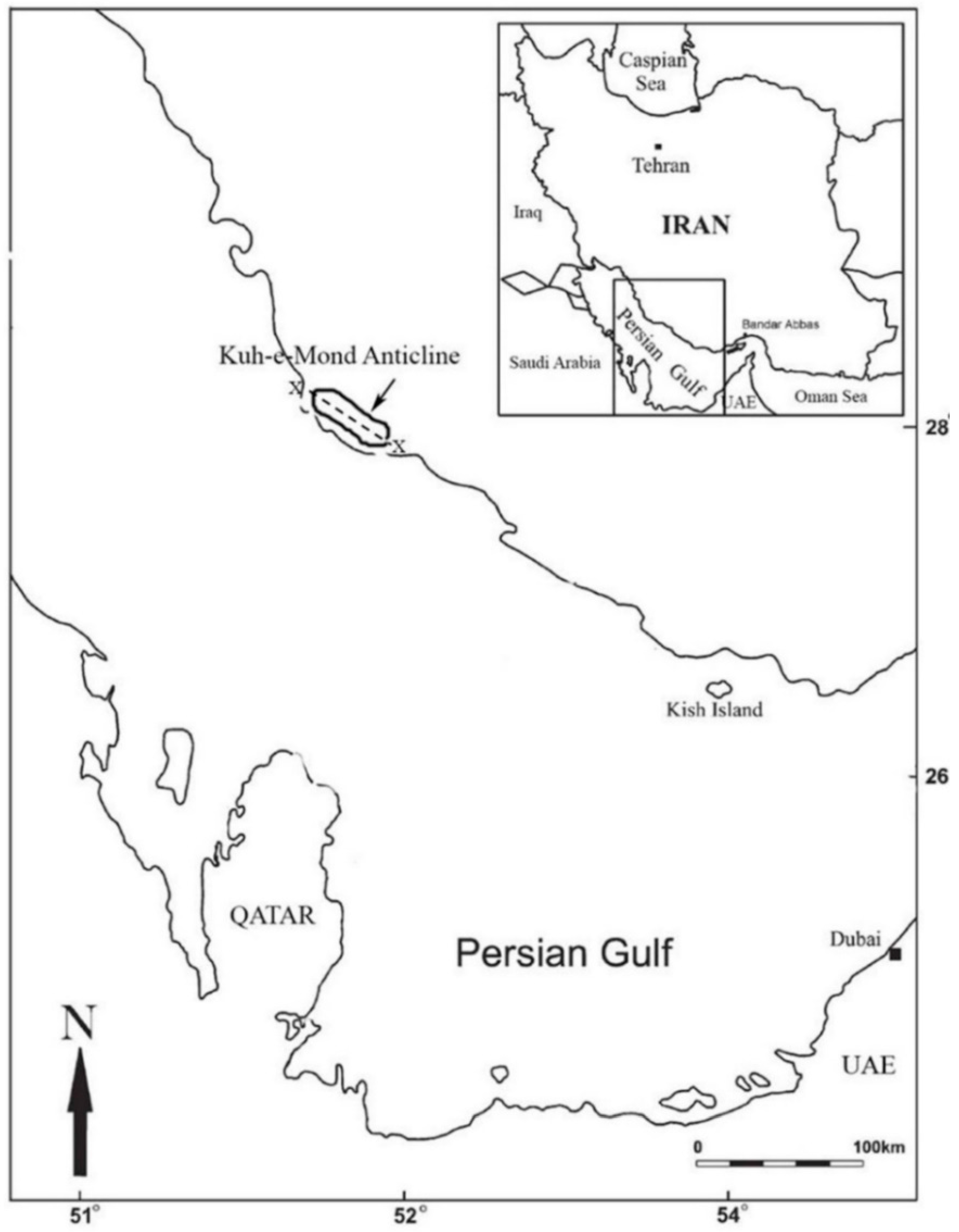


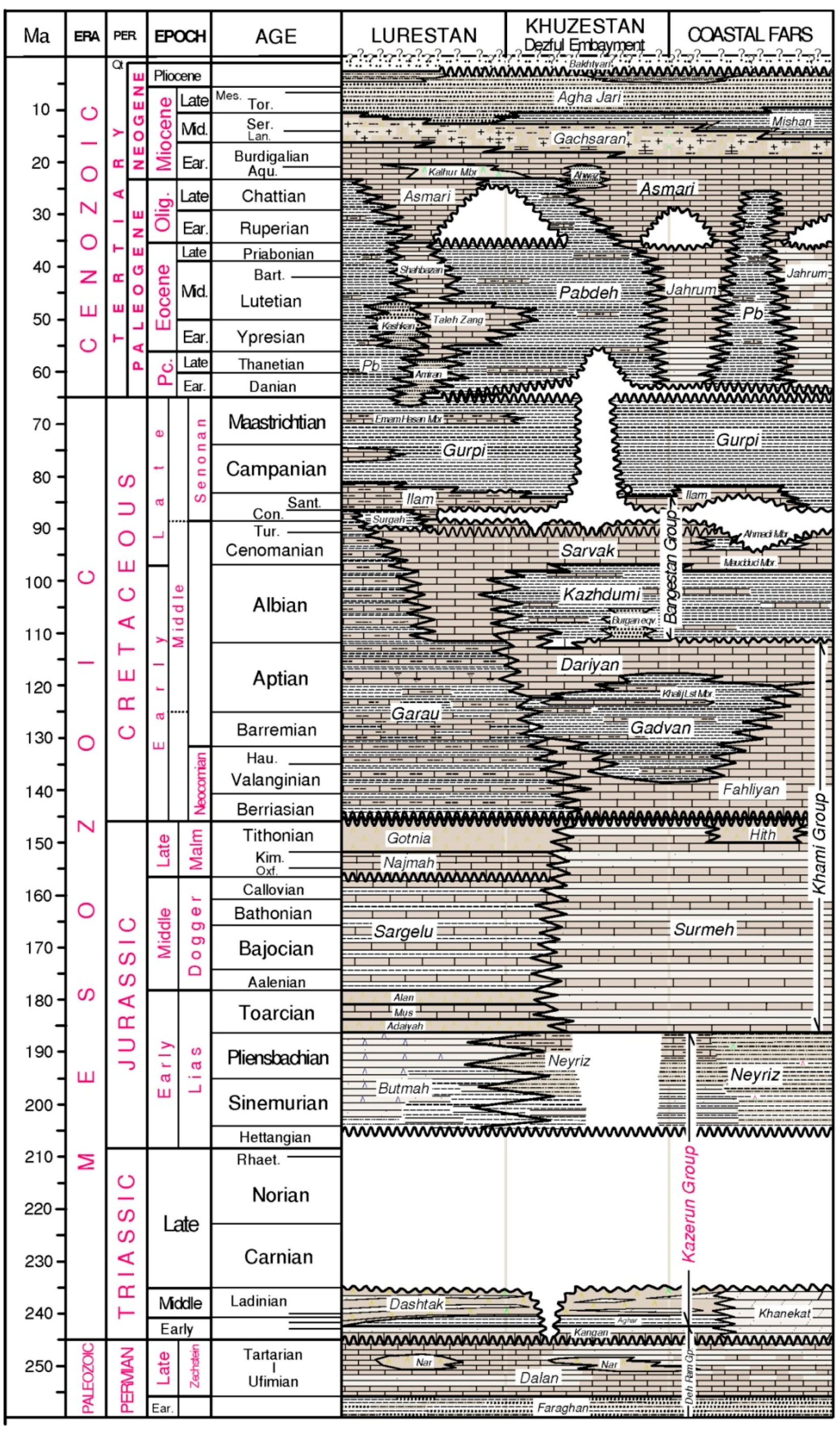
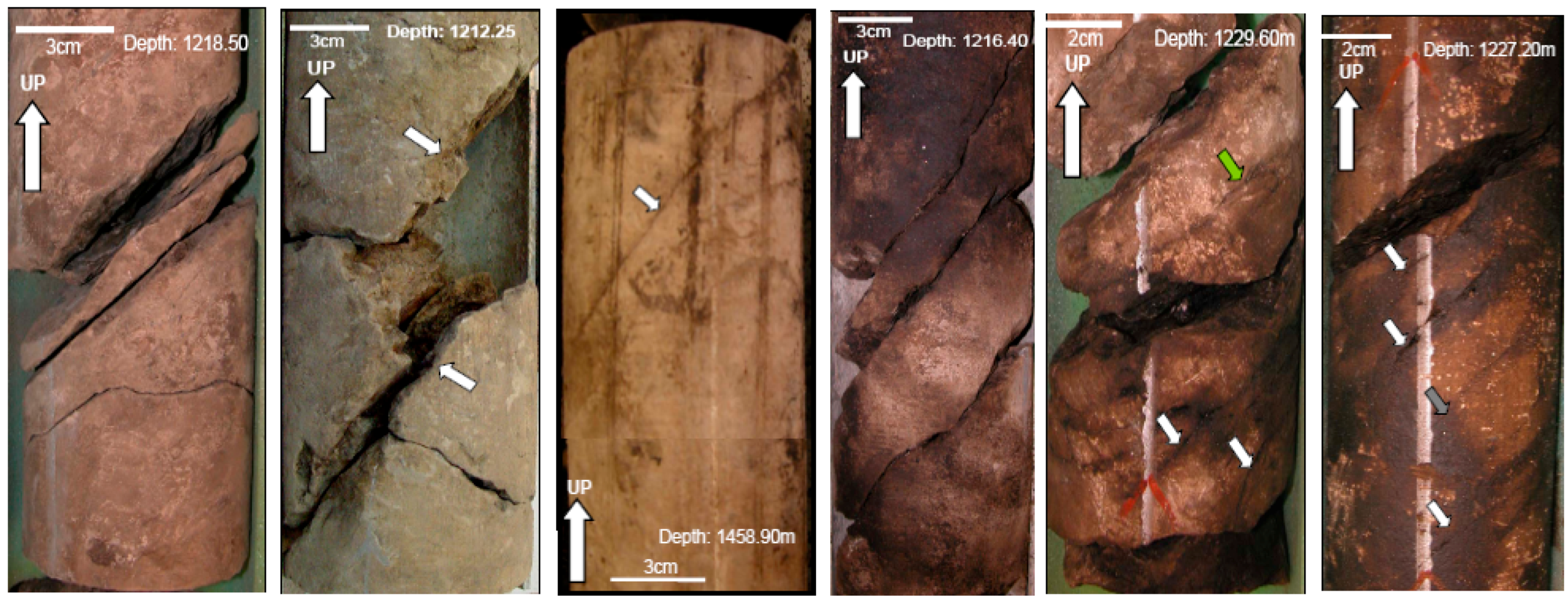
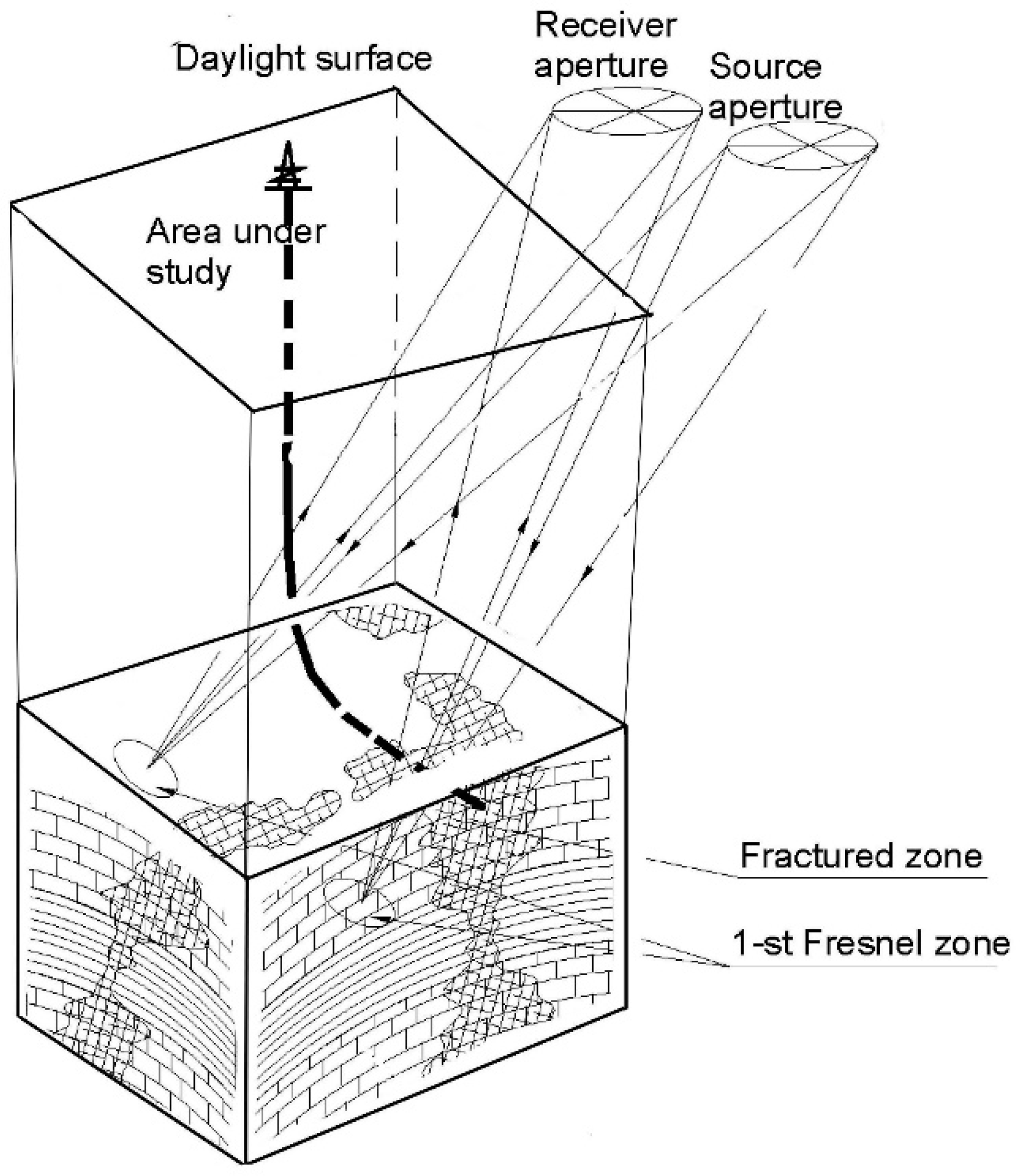
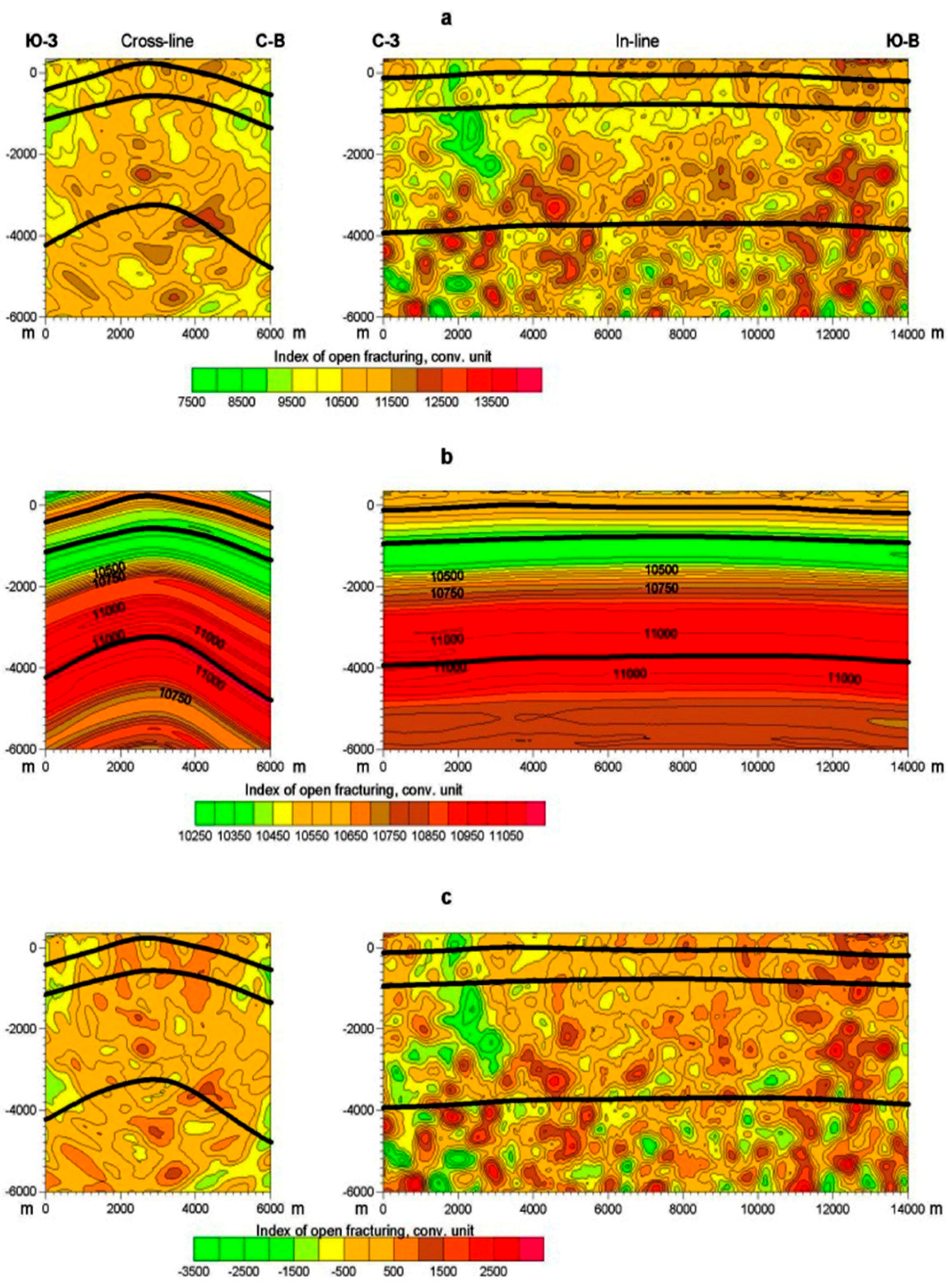

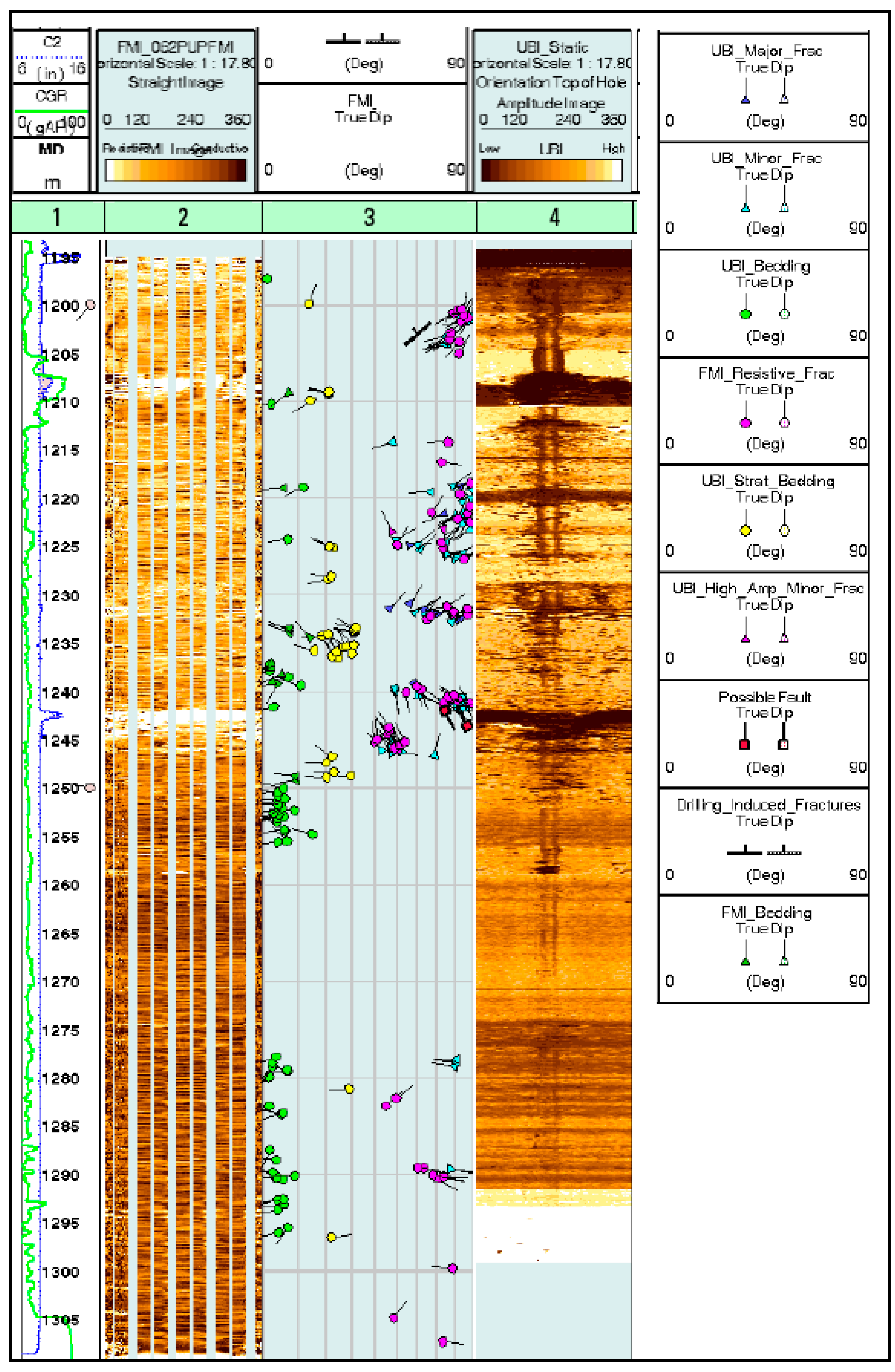
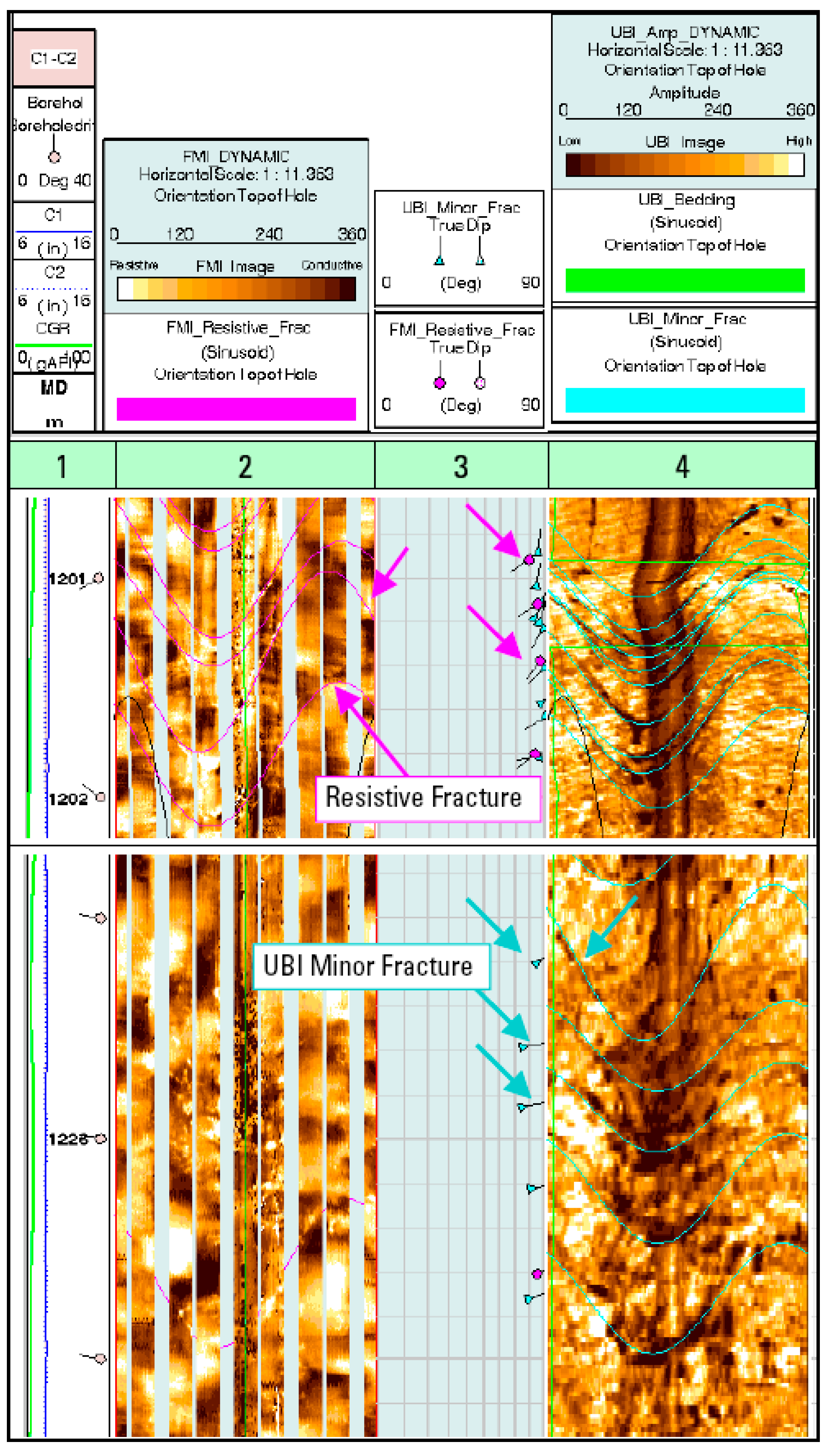
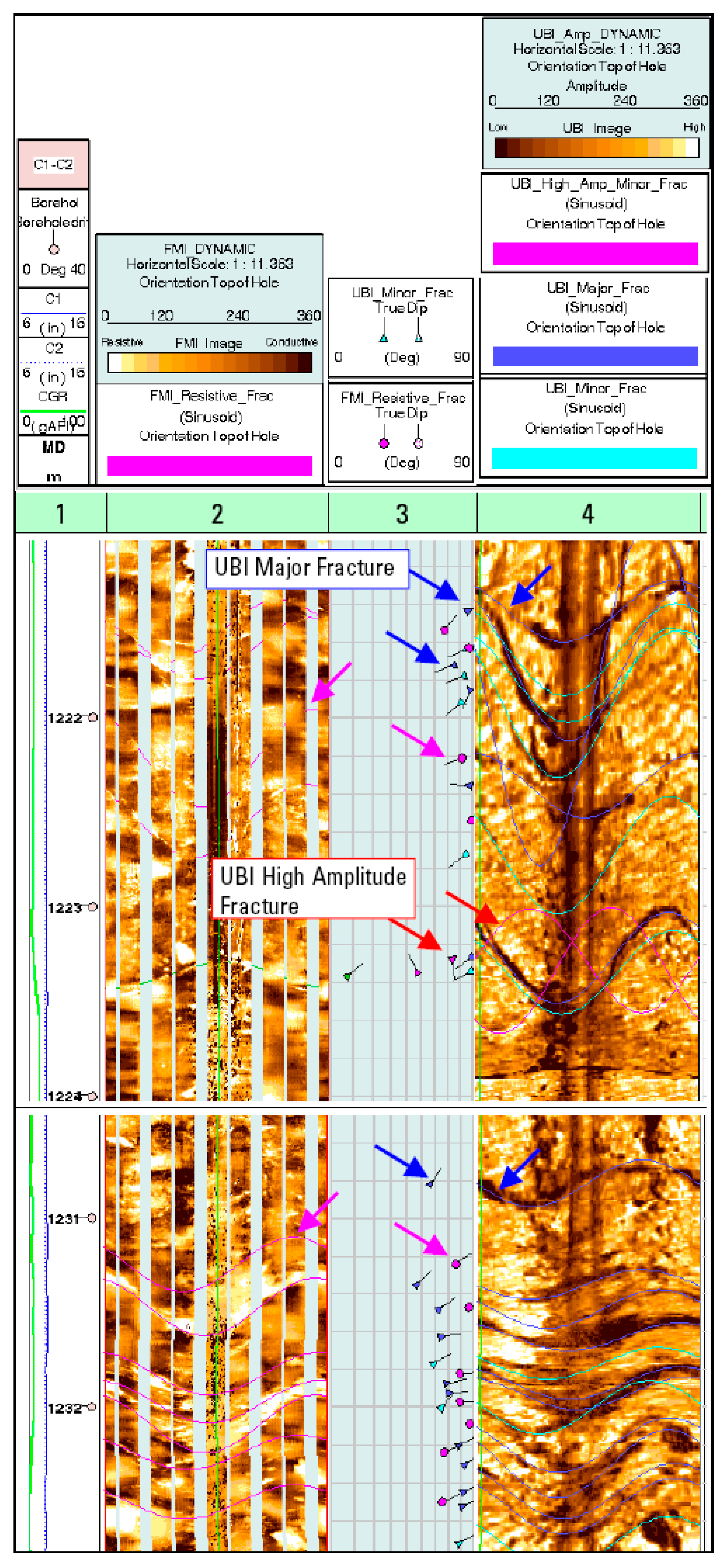
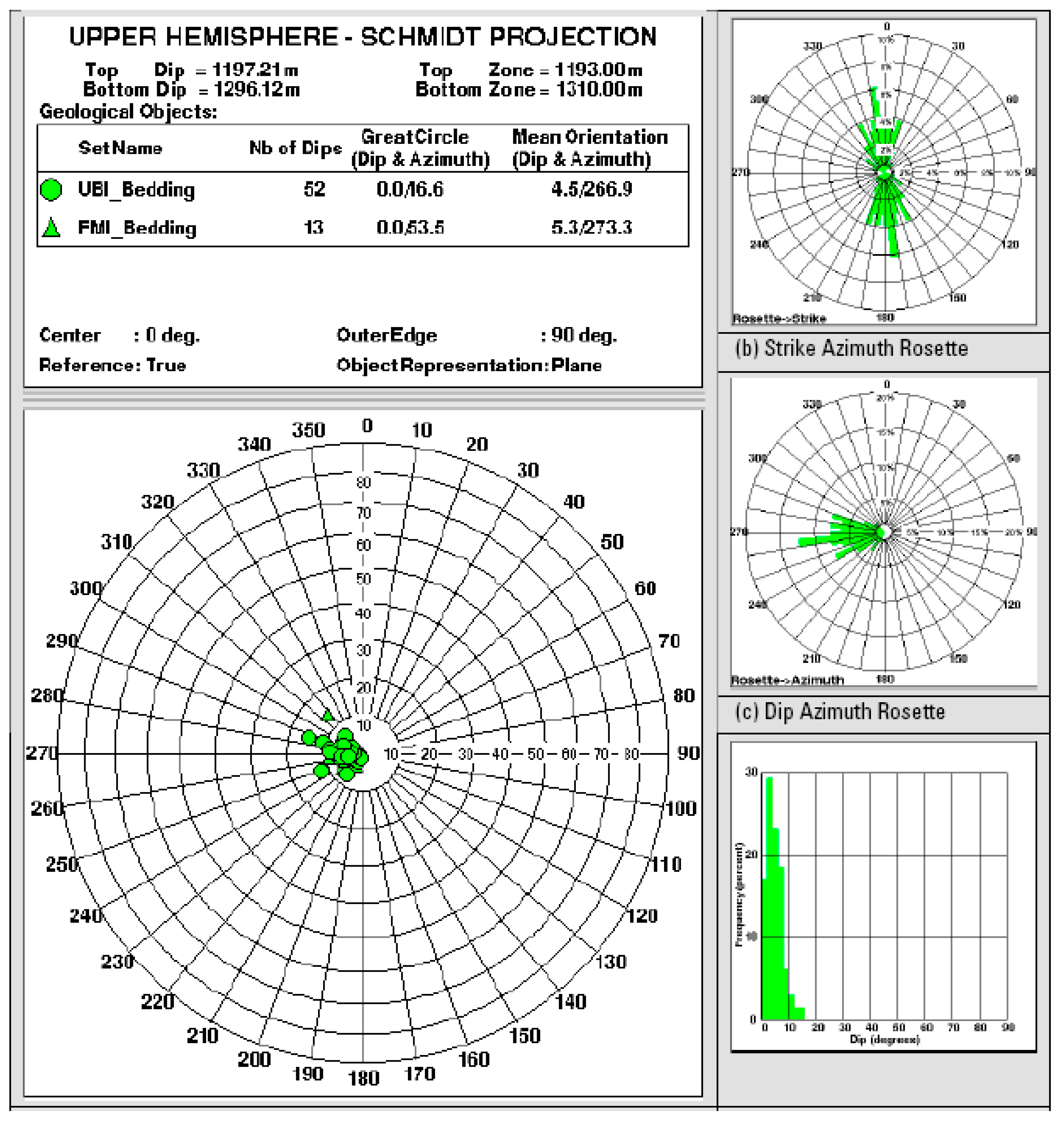
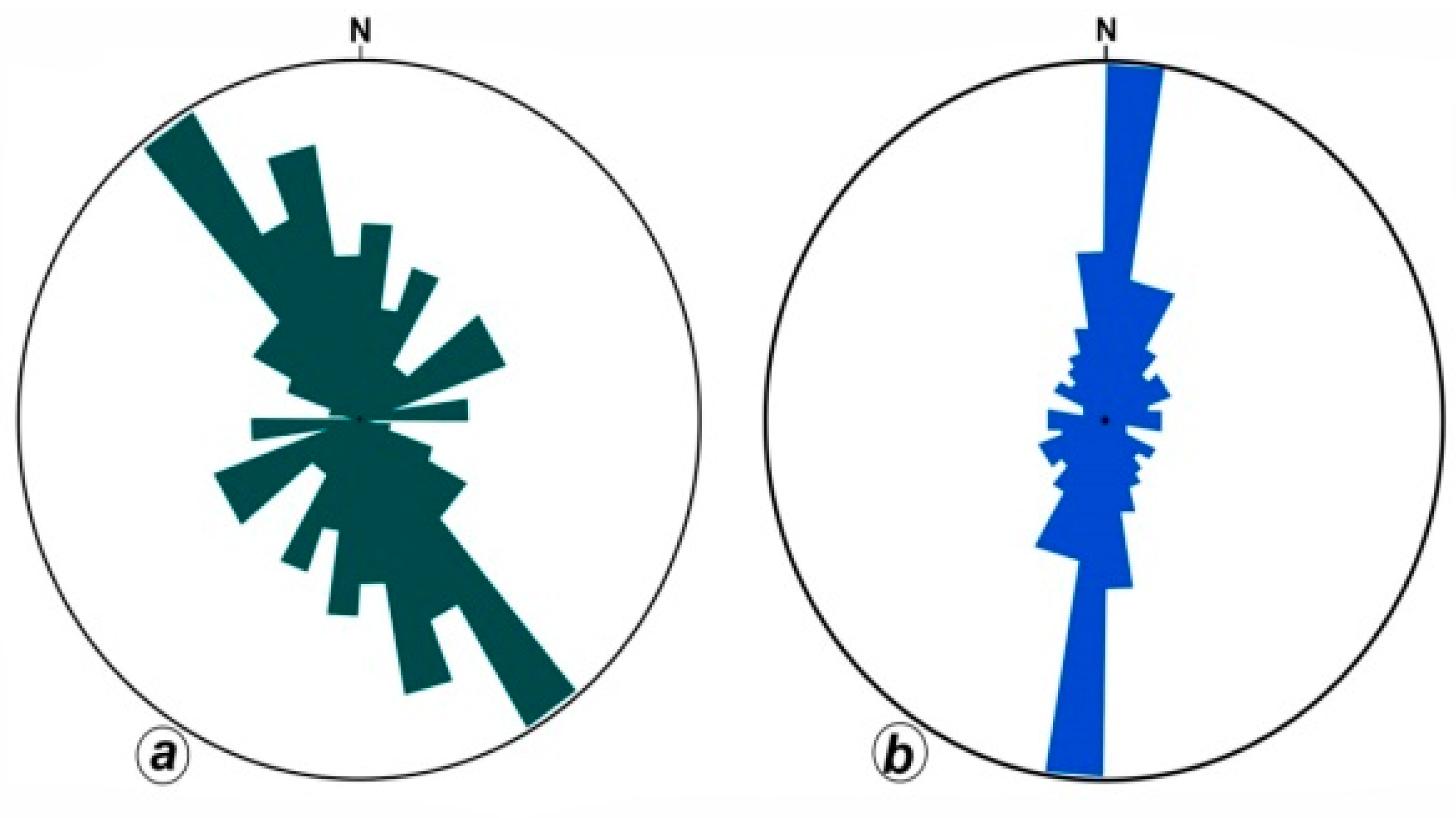

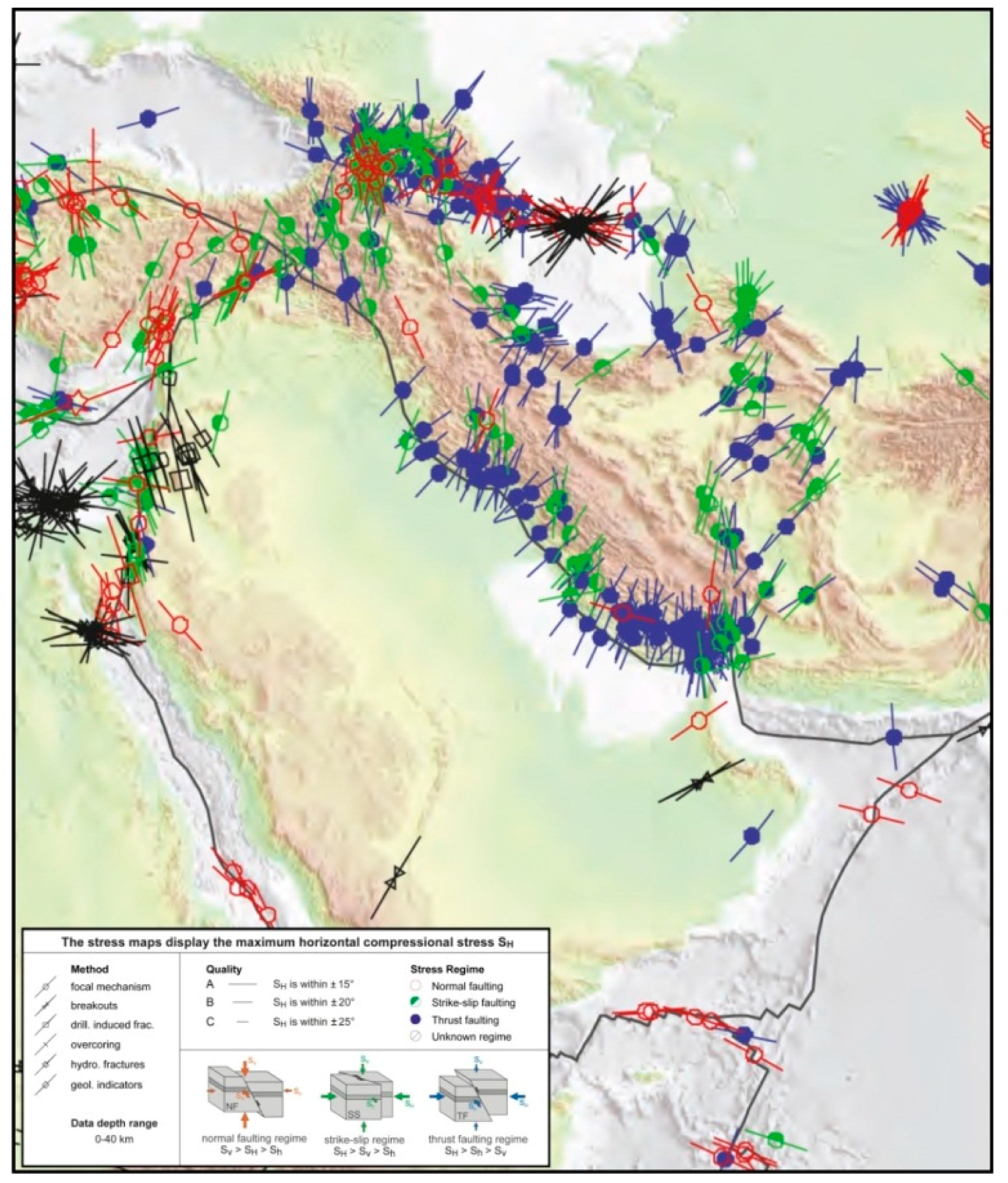
© 2018 by the authors. Licensee MDPI, Basel, Switzerland. This article is an open access article distributed under the terms and conditions of the Creative Commons Attribution (CC BY) license (http://creativecommons.org/licenses/by/4.0/).
Share and Cite
Shafiei, A.; B. Dusseault, M.; Kosari, E.; N. Taleghani, M. Natural Fractures Characterization and In Situ Stresses Inference in a Carbonate Reservoir—An Integrated Approach. Energies 2018, 11, 312. https://doi.org/10.3390/en11020312
Shafiei A, B. Dusseault M, Kosari E, N. Taleghani M. Natural Fractures Characterization and In Situ Stresses Inference in a Carbonate Reservoir—An Integrated Approach. Energies. 2018; 11(2):312. https://doi.org/10.3390/en11020312
Chicago/Turabian StyleShafiei, Ali, Maurice B. Dusseault, Ehsan Kosari, and Morteza N. Taleghani. 2018. "Natural Fractures Characterization and In Situ Stresses Inference in a Carbonate Reservoir—An Integrated Approach" Energies 11, no. 2: 312. https://doi.org/10.3390/en11020312




